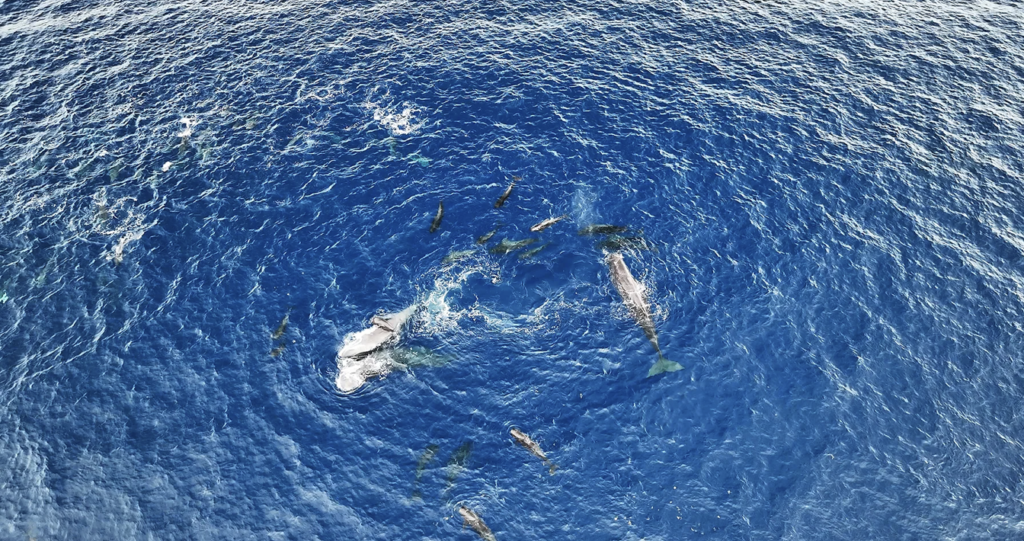Researchers Discover Complex Structures in Whale Communication Using AI
- AI Decodes Whale Communication: Researchers uncover a sperm whale phonetic alphabet with AI, revealing complex vocal structures.
- Sophisticated Social Behaviors: Sperm whales exhibit intricate social and decision-making behaviors, requiring advanced communication.
- Potential Linguistic Parallels: Findings suggest whale communication may have elements similar to human language, although further research is needed.
In a groundbreaking discovery, researchers have used artificial intelligence to decode a “phonetic alphabet” within sperm whale vocalizations, uncovering sophisticated structures reminiscent of human language. This achievement sheds new light on the complex social behaviors and communication methods of these ocean giants.

AI Decodes Whale Communication
Sperm whales, elusive creatures that spend much of their lives in the deep ocean, communicate using rhythmic sequences of clicks known as codas. Historically, it was believed that sperm whales utilized 21 coda types. However, the Cetacean Translation Initiative (Ceti) has identified 156 distinct codas after analyzing nearly 9,000 recordings. This research reveals the existence of basic building blocks within these codas, akin to phonemes in human language, which combine to form a diverse array of vocalizations.
Pratyusha Sharma, a PhD student at MIT and lead author of the study, described how AI identified “fine-grain changes” in whale vocalizations, including variations in the tempo and rhythm of codas. These subtle changes, such as adding an extra click at the end of a coda, suggest that whale communication might carry far more information than previously understood. These features indicate that sperm whale vocalizations could have contextual meanings, similar to how humans use tone and inflection to convey different messages with the same words.
Sophisticated Social Behaviors
Sperm whales live in complex, multi-level matrilineal societies, with groups consisting of daughters, mothers, and grandmothers, while males roam the oceans to breed. These groups are known for their intricate social behaviors and group decision-making processes, which necessitate advanced communication methods. For instance, they can adapt their collective behavior to protect against predators like orcas or humans.
Marine scientist Kirsten Young from the University of Exeter explains that while much of sperm whale behavior remains a mystery due to their deep-sea habitat, their communication is constant. Sperm whales often dive to depths of over 3 kilometers and can stay submerged for up to two hours, clicking continuously to communicate with each other over several kilometers.
Potential Linguistic Parallels
The discovery of a combinatorial coding system in sperm whale communication suggests potential parallels with human language. The researchers found that sperm whale “phonemes” could be used in various combinations to create a vast repertoire of vocalizations. This combinatorial system is a prerequisite for “duality of patterning,” a linguistic phenomenon where meaningless elements combine to form meaningful words, though this has not been definitively proven in whales yet.
David Gruber, lead and founder of Ceti, emphasized that while these findings are promising, they represent just the beginning of understanding whale communication. “We need to build a fundamental understanding of how sperm whales communicate and what’s meaningful to them,” he said. “Artificial intelligence is allowing us to see deeper into whale communication than we’ve ever seen before.”
Ideas for Further Exploration
- Interdisciplinary Research: Combining marine biology, linguistics, and AI to further decode and understand sperm whale communication.
- Ethical Considerations: Ensuring that research respects the natural behaviors and habitats of sperm whales without intrusive methods.
- Conservation Efforts: Using insights from whale communication studies to enhance conservation strategies and protect whale populations.
Despite the excitement around these discoveries, some experts caution against an anthropocentric focus on language, which may limit our understanding by forcing human perspectives onto whale behaviors. Nonetheless, the use of AI to decode whale communication marks a significant advancement in marine science and opens up new avenues for understanding these enigmatic creatures.
